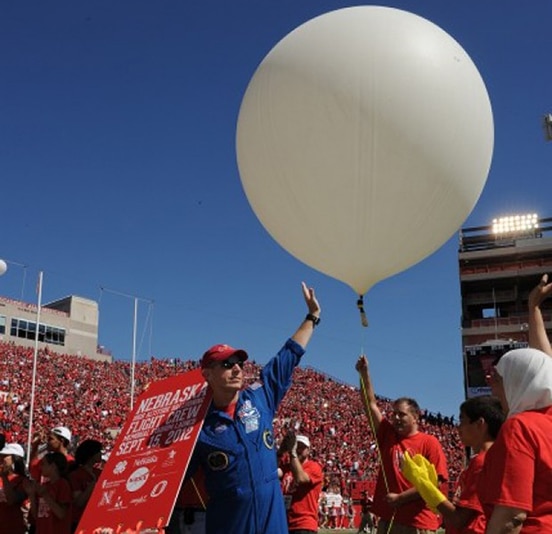Photo by: ERIC GREGORY/Lincoln Journal Star
In our last post, we introduced a team from the University of Nebraska that planned to launch a high altitude balloon at a Huskers football game in front of roughly 85,000 fans. Because of how unique a high altitude balloon launch experience is, they garnered a lot of interest from neighboring middle schools and a 4-H club that wanted to participate. Given the interest, the team decided to launch two balloons to carry the experiments that would be designed and created by the students, as well as a third balloon that would carry a Cornhuskers banner into near-space.
The students from Omaha Bryan Middle and Omaha McMillan Magnet schools designed their own experiments to send into near-space. They designed their experiments to test the affects of the atmosphere on seeds, insects, food, and other substances. Designing experiments for a high-altitude balloon launch is a multi-faceted experience for students, from middle schools on into college levels. The students have to work together to create and hypothesize an experiment, and then design it to fit into the limited constraints of the payload box. Too heavy, and the balloon won’t be able to carry it; too large, and it won’t fit in with the other experiments within the box. It teaches students to work together in a group, as well as work together with other groups to coordinate experiments in such a way that every experiment fits.
On September 15, launch day, the balloons were prepared to be sent off during halftime of the Huskers game. One even popped as it was being filled, but luckily they had a backup ready to go. In addition to the experiments, the balloons also carried traditional equipment, like StratoStar’s turn-key flight system to transmit data in real-time, Automatic Packet Recording System (APRS), GPS, high definition video cameras, and data-collecting sensors that would help monitor the changes in atmospheric temperature, pressure, and measure cosmic rays as the balloon ascended.
Because the experiments with high altitude balloons can allow students to explore the effects that formerly only NASA scientists and astronauts have been able to test, it was only fitting that Nebraska’s native astronaut Clayton Anderson was on the field with the kids as they launched their balloon.
After the balloons were launched, a chase team took after them, monitoring their location via GPS, to collect them once they gently floated back to Earth. The students, as well as the fans, were able to watch the balloons’ progress and check the monitors live via a site hosted on the UNL website.
In our next post, we’ll highlight some of the flight information and data collected from the balloon launch, as well as showcase a couple of videos from the launch! In the meantime take a look at our free e-book downloadon how to get funded with StratoStar for your next launch.



